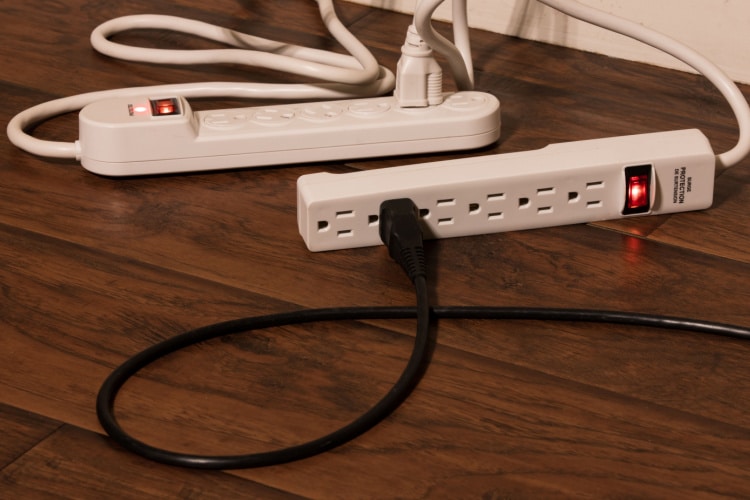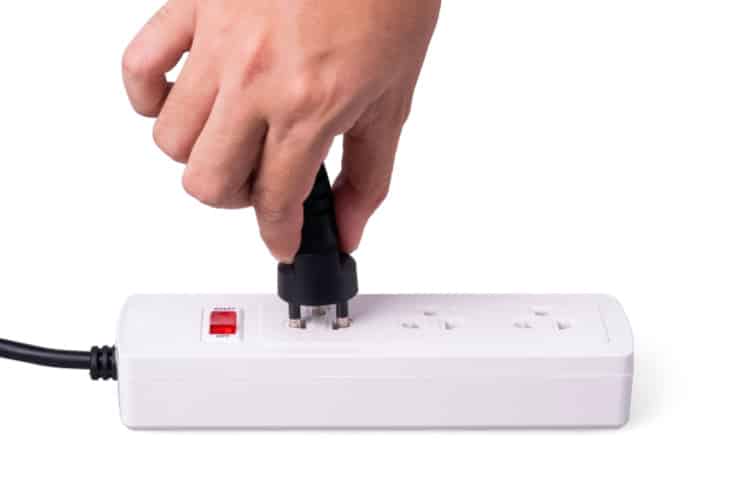With a surge protector, a single outlet can readily become available for six or more electronic devices. But what happens if we need to connect even more? Can we daisy chain power protectors?

Although it’s a practice many of us are probably guilty of doing at one point, please be ware that plugging one surge protector into another is against Occupational Safety and Health Administration and National Fire Protection Association (NFPA) safety rules. So, you can not plug a surge protector into another surge protector. Let’s see why.
The Consequence of Plugging Surge Protector Into a Surge Protector
If you examine the surge protector packaging, you’ll see a warning label that reads, “Do not daisy chain.” There’s a good reason for that label.
When discussing electricity, daisy-chaining has nothing to do with making a garland but rather with connecting multi-plug adapters to one another. Doing so will give you more receptacles and cords long enough to plug every device in the room.
It seems like a great solution, yet according to the NFPA, daisy-chaining surge protectors are a severe fire hazard.
If daisy-chained surge protectors cause property damage and/or injuries, the affected parties are allowed to file a claim against you.
The warranties on your damaged items will also be void.
What Happens When We Daisy-Chain?
Surge protectors typically support electrical currents up to 15 to 20 amps translating to 1,800 to 2,400 watts per outlet. So, plugging a surge protector into another surge protector and stacking them with multiple devices will exceed the wattage limit.
Since surge protectors cannot handle high power demands, their fuses will likely blow. And if the fuses don’t explode, which frequently happens with cheap surge protectors, the circuit will become overloaded. As a result, the wiring will eventually overheat and melt. And all it takes is a tiny spark for an electrical fire to start.
How Dangerous Is an Electrical Fire?
Electrical fires are very dangerous. If you believe you’ll be able to put it out using water, you’re wrong. Water conducts electricity, so don’t be fooled into pouring water over it — you’ll get electrocuted!
Electrical fires require a special kind of extinguisher known as a class C fire extinguisher.
Additionally, chances are that plugged-in electronics and appliances will sustain irreversible damage during an electrical fire.
In a worst-case scenario, the fire will expand quickly and cause damage to the structural integrity of your house.
So, based on everything we discussed, daisy-chaining is a big no-no.
Can You Plug a Power Strip Into a Surge Protector?

It’s not safe to plug a power strip into a surge protector because it’s a fire hazard and violates the Occupational Safety and Health Administration and National Fire Protection Association (NFPA) safety rules.
For the reasons listed above, connecting a power strip to a surge protector will result in blown fuses, overheated wires, overloaded circuits, and ultimately a hazardous electrical fire that quickly spreads throughout the building and is, unfortunately, very difficult to put out. The same will happen when daisy-chaining surge protectors and power strips into an extension cord.
Confusing Power Strips for Surge Protectors
Many people believe connecting their power strips and surge protectors into a daisy chain is no big deal. But we explained why doing so is dangerous and against the rules and possibly local safety laws.
Another common misconception is that surge protectors and power strips are the same. They aren’t, and mistaking them could lead to electrical damage!
A power strip aims to provide more outlet space so you can connect multiple devices at once. Surge protectors have a dual function. They provide additional outlet space and shield your plugged-in devices from power surges brought on by lightning strikes, electrical overloads, faulty wiring, etc.
They look very similar, as both have lengthy cables, multiple plugs, and an on/off switch. Surge breakers, however, have two features that make them unique: an LED light indicating the device’s lifespan and a Joules rating indicating the maximum energy it withstands. A greater Joules rating means better protection.
Buying a power strip, believing it will protect your devices from a power surge, will lead to damaged equipment. Your devices and appliances aren’t safe with a power strip.
Safety Tips on Using Surge Protectors, Extension Cords, and Power Strips
The National Fire Protection Association (NFPA) reports that inappropriate use of multi-plug equipment is one of the major causes of electrical fires.
So, our first advice for you is to discontinue daisy-chaining extension cables, power cords, and surge protectors.
Another tip is never to overload the circuit. Instead, ask yourself, “Do I need all the plugged-in devices to operate simultaneously?” Chances are no, so prioritize what needs to be plugged in and what can wait for later.
If you do need more outlet space, the best course of action is to update the electrical system in your home.
If purchasing a surge protector seems more straightforward and cost-effective in comparison, always choose models with higher joule ratings and approval labels from OSHA’s Nationally Recognized Testing Center. Multi-plug adapters that are not certified could have faulty cabling and lead to an electrical fire.
Additionally, never plug appliances with built-in heaters and machines, like fridges, ovens, dishwashers, microwaves, air conditioners, dryers, washers, freezers, grills, etc. They draw a lot of electricity and easily overload and overheat the circuit.
Devices that won’t overload the circuit include TVs, PCs, lamps, coffee makers, gaming consoles, chargers for laptops, smartphones, or tablets, digital clocks, modems, blenders, toasters, etc. These devices don’t consume a lot of electricity and are safe to plug into a surge protector, power strip, or extension cord.
Even so, the number of plugged-in devices should be minimal. If the surge protector, power strip, or extension cord is hot to the touch, chances are you have plugged more devices than it supports. Unplug some of them.
Conclusion
Multi-plug gadgets are convenient, and we frequently take advantage of this by daisy-chaining them to create more outlet room and lengthier power cords.
But the reality is that we don’t realize the danger we’re creating when trying to be creative in finding practical solutions to our modern-day problems.
So, to repeat the main takeaway, don’t plug one surge protector into another. It violates NFPA safety regulations, poses a severe fire risk, puts you at risk of lawsuits, and it has potential for damaging your equipment and preventing you from getting a warranty replacement.
The same applies to daisy-chaining power strips and extension cords.
We hope this article will help you make safer and wiser decisions!